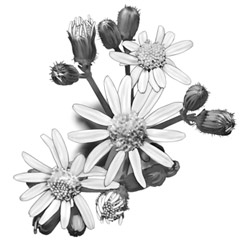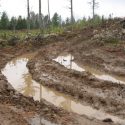UW–Madison botanist plucks new flower from Isle Royale
One of the world’s newest sunflower species, discovered by a University of Wisconsin–Madison botanist, has carved out a very small but safe niche on an island in Lake Superior.
Robert R. Kowal, an emeritus professor at UW–Madison, received his first Packera insulae-regalis specimen in 1972 from a student who had made a trip to Isle Royale, a Michigan national park just a few miles over the cold waves from Canada.
“It’s of absolutely no agricultural or economic significance, but it is a previously unrecognized biological entity and, as such is intellectually interesting,” says Kowal, an expert on the genus Packera of the sunflower family, which is one of the largest plant families on the planet. “It’s a rather nondescript but still unique species.”
A little more than a foot tall while flowering, Packera insulae-regalis produces groups of small heads (similar to the common sunflower) with narrow yellow rays. When it’s not flowering, the plant bears just a few leaves at ground level.
Sept. 1 marked the plant’s debut as a distinct species with a description in the journal Brittonia — authored by Kowal, UW–Stevens Point biology and forestry professor Emmet J. Judziewicz and Williams College biology professor Joan Edwards — but it has likely been growing along a path on Isle Royale’s Mount Franklin for thousands of years.
“The species is known only from one population along the trail used by hikers moving along the ridge that forms the spine of the island,” Kowal says. “The plants are probably saved by the trail. If the area was allowed to go to forest, this species would probably be shaded out and go extinct.”
Initially, Kowal believed the plant that would become Packera insulae-regalis — which means in Latin “the Packera of Isle Royale” — was a species known to grow on Isle Royale’s damp banks. Or maybe another similar species that grows in drier areas around Lake Superior, but not on Isle Royale.
“Over the years I gradually became aware of differences between those two species and this plant in their flowering structures,” Kowal says. “Eventually I counted its chromosomes and this provided evidence of an important biological difference.”
The new plant has six sets of chromosomes — referred to as hexaploid — while the two similar species have four (tetraploid) and eight sets (octoploid), respectively.
“It is genetically isolated from the other two,” Kowal says. “The simplest idea of its origin is via a cross between the tetraploid and the octoploid.”
Kowal grew and studied the new species for three decades in research plots in the UW Arboretum and his own Madison backyard.
“I belong to an older school of taxonomy know as biosystematics — living plants are studied to determine their morphological differences, breeding systems and chromosome numbers,” he says. “For example, samples from the field are grown together in the same garden to see what they look like under similar conditions. The kind of work I do, though old-fashioned, is not the kind of work you can do with DNA.”
Or the sort of work that happens overnight. Kowal, who retired in the 1990s, and says he was always more focused on teaching than research, intends to publish descriptions of a handful of new species of Packera in the next few years.
“For many of these things, I’m the only person who cares — or knows — about them for the time being,” Kowal says. “But it’s hard to predict how future researchers may be able to make use of basic knowledge like this. Moreover, it’s important to know they exist before their habitats are completely destroyed by development and they go extinct. Knowing they exist may help preserve them.”



